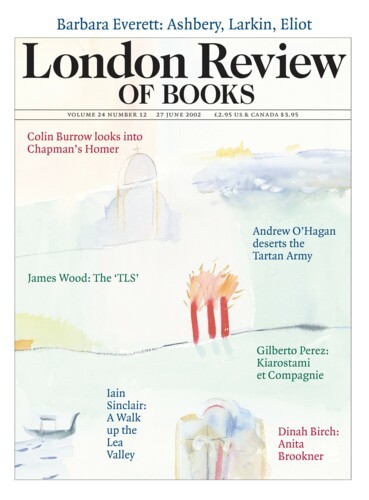Results are in for ‘Dream Lab: The Big Library Experiment’. Ten thousand library-goers filled in questionnaires about their reading and dreaming habits, and the numbers have been crunched by Mark Blagrove, a psychologist at the University of Wales, Swansea. It turns out that readers of fiction are more likely than non-readers of fiction to have ‘bizarre dreams’ in which impossible or unlikely things occur. Last night I dreamed that I was an assistant rhinoceros trader in ancient Athens called Ali Shah. How this might be connected to John Updike’s ‘Rabbit Remembered’, the last bit of fiction I’d read, I don’t know. Waking up, I thought the dream might be useful for Short Cuts and, taking the notebook and pencil I keep handy next to the bed, scribbled down the name ‘Ali Shah’, worried that I might forget it as the dream faded. The curious thing about this event, though it didn’t seem curious at the time, is that I don’t keep a notebook and pencil next to the bed. I had been, I realised when I really woke up, still dreaming. Or rather dreaming again. Had I realised that I was dreaming as I picked up the pencil, or even as I haggled fiercely over the asking price of a prize rhino, I would have been having a ‘lucid dream’, something only 58 per cent of adults have ever experienced. By contrast, the altogether less enviable business of dreaming you’ve woken up is too common to merit enquiry.
Those professing the ability to interpret dreams, from Joseph to Freud, have always wielded a peculiar power. The predominant scientific view at the moment, easing the amazing technicolour rug from under the feet of the prophets and seers of the past, is that dreaming, if it has any function at all, is probably connected to the laying down of memories. Their content, if it has anything to do with anything, probably has to do with events of the preceding day – which would include any reading of books that might have taken place. It is not after all very surprising that people who are more likely to encounter dragons (or for that matter rhinoceroses) in books are also more likely to encounter them in their dreams. But there is another, perhaps more interesting aspect of the relationship between storytelling and dreams, which works in the opposite direction. There is not, at least not yet, a machine to allow an outside observer – a category that would include the dreamer herself when awake – to plug into a sleeping person’s mind and perceive a dream directly and consciously. For a third party, such as an analyst, the experience has to be mediated through the dreamer’s own account of it: a dream has to be turned into a story before it can be analysed, and there can be no corroborating evidence from elsewhere, no DNA fingerprints or CCTV. This is perhaps one reason why the science of dreams is so hazy – the kind of raw data to which scientific methods can be applied just isn’t available. Instead, there are stories. And the technique most commonly applied to the interpretation of dreams is a kind of literary criticism. Freud, of course, was a master of it. And the ways in which people tell stories, particularly perhaps the ways in which they make stories out of their dreams, can probably tell you more about their unconscious minds than their dreams can. But then again, it may just be that in a past life I helped sell rhinos to the ancient Greeks.
Martin Amis, whatever he may have been in a past life, is currently turning into Gyles Brandreth. Blazoned across the Daily Telegraph on 13 June were pictures of the eminent novelist in sports kit that David Beckham might not be ashamed to be seen in. Pilates, we learn, has changed Martin Amis’s life. It’s got him onto the health pages of the Telegraph, for one thing. ‘It’s a bit girly, but it really works,’ he enthuses to Victoria Lambert as she joins him for a session with Pilates guru Dreas Reyneke. Christopher Isherwood was a devotee of the exercise technique, devised by Joseph Pilates in the 1930s, so it has a strong literary pedigree. The ‘52-year-old writer’ – that’s Amis – ‘has been attending Reyneke’s Notting Hill studio twice a week for the past three years, ever since his wife, Isabel Fonseca, told him it was a good idea.’ But what’s this? Three months ago, Gyles Brandreth appeared in the Sunday Telegraph in his gym kit. His ‘Diary of an Old Body’ began two years previously, on 8 March 2000: ‘It is my 52nd birthday . . . I sauntered into the kitchen and said to Michele, my wife: “How do I look?”’ So of course she told him and off he went to the gym. The resemblance is uncanny. Eugène Ionesco, where are you now?
Send Letters To:
The Editor
London Review of Books,
28 Little Russell Street
London, WC1A 2HN
letters@lrb.co.uk
Please include name, address, and a telephone number.

